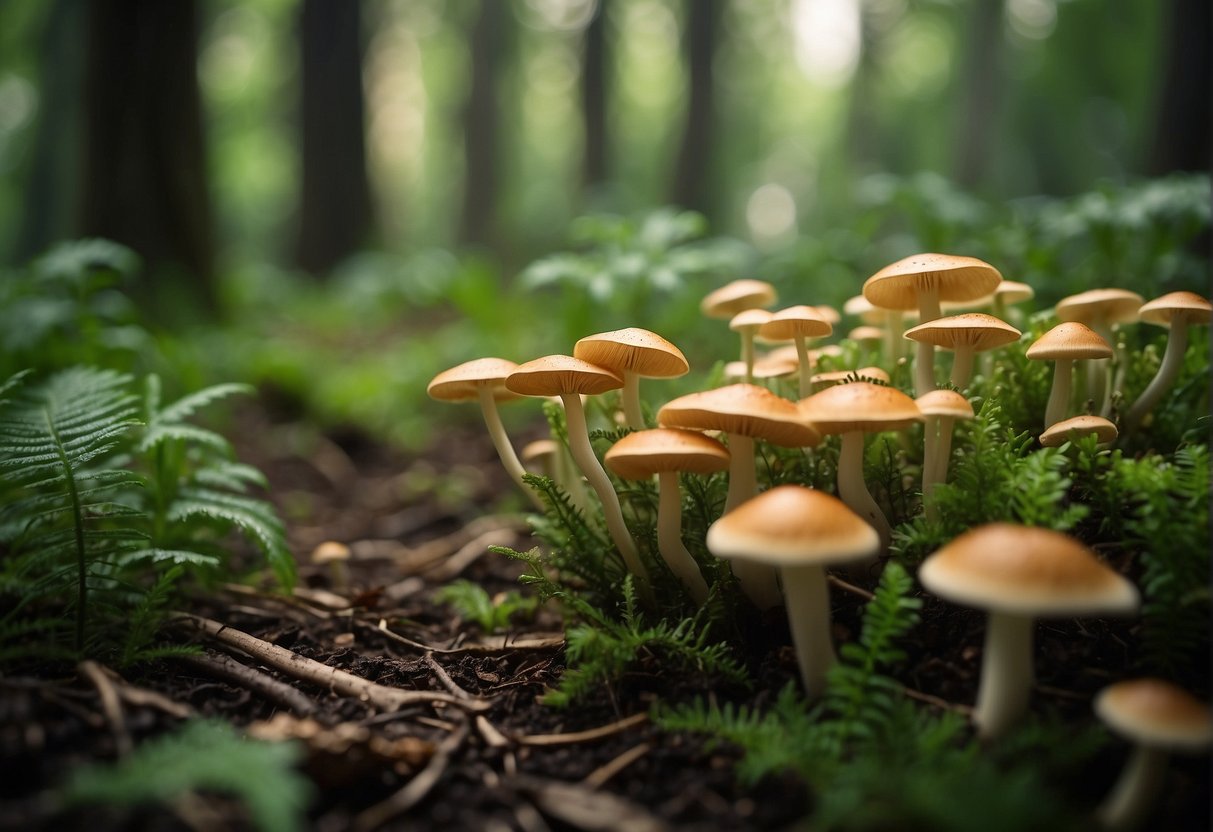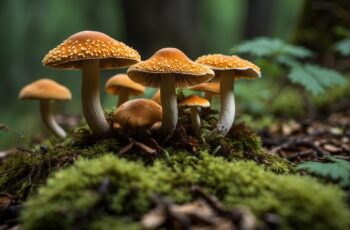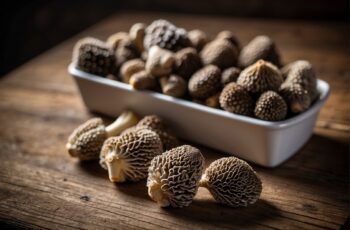Edible mushrooms are a remarkable food source that offer both a variety of flavors and a plethora of health benefits. In the vast kingdom of fungi, there are thousands of mushroom species, yet only a select few are delicious and safe for your dinner table. These culinary delights can be found across the world, growing in different climates and regions. Whether you’re a gourmet chef or a weekend forager, knowing which mushrooms you can eat is essential.

The journey of incorporating mushrooms into your meals starts with proper identification, as the distinction between edible and potentially harmful mushrooms is critical for your safety. If you’re foraging, gain knowledge from reputable guides or experienced foragers. When you’re cooking, mushrooms offer versatility—from enhancing a simple stir-fry to being the centerpiece of a sophisticated dish. Beyond their unique flavors, mushrooms are known for their nutritional value, providing a source of protein, vitamins, and minerals that can benefit your overall health.
Key Takeaways
- Not all mushrooms are edible, and correct identification is crucial for safety.
- Mushrooms can be a versatile and tasty addition to meals, offering various culinary uses.
- Consuming mushrooms can contribute to a balanced diet due to their nutritional content.
Identifying Edible Mushrooms
In the search for edible mushrooms, your knowledge and attentiveness are your best tools. Here’s how to distinguish the ones you can enjoy from those best left untouched in the wild.
Foraging Tips
When you’re out foraging, remember to always have a field guide or a knowledgeable person with you—mushrooms can be tricky to identify. Check the gill color and stem structure carefully; for example, choice edibles like oyster mushrooms have gills that run down a stubby, off-center stem. Take two baskets: one for mushrooms you’re sure are safe, and another for those you need to verify.
Common Edible Species
You’ll come across several edible mushrooms that are not only delicious but also common. Morels are highly prized, with their unique honeycomb appearance, while chanterelles boast a vibrant color and a funnel shape. Shiitake, lion’s mane, and oyster mushrooms are among the sought-after species for their taste and texture. When foraging, make sure you’re picking the actual maitake mushroom and not its toxic lookalike. For those starting, button mushrooms and portobello mushrooms are easily identifiable and widely available.
Poisonous Lookalikes
Extreme caution is essential as some edible mushrooms have dangerous lookalikes. The toxic false morel closely resembles the edible morel but is harmful if consumed. Similarly, jack-o’-lantern mushrooms may look like chanterelles but are toxic. Always cross-reference and avoid mushrooms with red on the cap or stem, which can suggest toxicity.
Preparing and Cooking Mushrooms
When you’re out from a day in the woods or picking up some choice fungi from your local market, knowing how to prepare and cook mushrooms can transform your meals. Each variety brings its own unique texture and flavor, suitable for a range of dishes, from rustic soups to gourmet creations.
Cooking Methods
- Sautéing: Heat up your pan, add a bit of oil or butter, and toss in thinly sliced mushrooms such as button or shiitake. You’re aiming for a golden-brown sear that locks in the meaty flavor. Stir frequently to ensure even cooking.
- Grilling: Portobello and oyster mushrooms are prime candidates for grilling. Brush them with oil, season, and place them on a hot grill. They’ll pick up a smoky flavor that complements their natural taste.
- Stir-Frying: Keep things moving in a hot wok to give shiitake or oyster mushrooms a crisp-tender texture, perfect for stir-fries and Asian-inspired dishes.
Recipes and Pairings
- Salads: Raw cremini mushrooms or thinly sliced button mushrooms add a mild flavor and crunch to your greens. Pair them with a robust dressing to enhance their taste.
- Stuffed Mushrooms: Choose larger caps like Portobello, fill them with a mix of cheese, breadcrumbs, and herbs, and bake until bubbly.
- Soups: Enhance your broths with a medley of mushrooms. Chopped chanterelles bring an earthy tone to creamy soups or clear broths.
Storage and Preservation
- Refrigeration: Store them in a paper bag in the fridge to maintain freshness for several days.
- Drying: For long-term storage, cleanly slice and dry your mushrooms using a dehydrator or in a low-temp oven. Store the dried mushrooms in an airtight container.
Selecting the right mushrooms and using appropriate cooking methods will elevate your culinary game whether you’re serving up a hearty stew by the campfire or grilling up a feast back home.
Health Benefits and Nutritional Information
When you’re foraging for fungi or perusing the produce aisle, consider the impressive nutritional profile mushrooms offer. A great source of fiber, they help maintain a healthy digestive system. But that’s just the start – dive into a variety of mushrooms, and you’ll find a treasure trove of nutrients.
Mushrooms are low in calories but rich in B vitamins such as riboflavin (B2), folate (B9), thiamine (B1), pantothenic acid (B5), and niacin (B3) which are essential for turning food into energy and maintaining a healthy nervous system. For instance, a cup of whole cremini mushrooms contains only about 15 calories, yet it’s packed with 2.2 grams of protein and a minuscule 0.1 grams of fat. You can appreciate these benefits regardless of whether you enjoy them raw or cooked.
Aside from these, mushrooms also hold medicinal virtues. Certain types, like Shimeji, are known for their cancer-fighting properties and may boost your immune system. These little warriors are armed with antioxidants like selenium, which take on the task of defending your cells from damage.
Here’s a brief overview:
- Calories: Low
- Protein: Rich
- Fiber: Good source
- Fat: Very low
- B Vitamins: Abundant
- Antioxidants: Present, such as selenium
Remember, while mushrooms offer many health benefits, wild mushrooms can also pose risks if you’re not an experienced forager. Some wild varieties can cause adverse effects like nausea, so always ensure proper identification or stick to trusted sources.
Mushroom Cultivation and Environmental Impact
Mushroom cultivation offers a sustainable food source with a low environmental footprint, appealing to those who enjoy the bounty of nature responsibly.

Home Cultivation
Growing mushrooms at home is a rewarding experience that allows you to produce a variety of edible fungi such as shiitake, oyster, and lion’s mane mushrooms. These varieties are prized for their meaty texture and are staples in Asian cuisine. To get started, you’ll need spores and a controlled environment—usually a humid and dark space. Shiitake mushrooms grow well on hardwood logs, while oyster mushrooms prefer straw or coffee grounds. King oyster mushrooms, distinct for their thick stems and savory flavor, are also a popular choice for at-home cultivation.
- Homegrown mushrooms such as Agaricus bisporus, which includes white and portobello mushrooms, can be easily cultivated in clusters in your own space.
- Remember, your mushrooms need a stable environment: keep the temperature and humidity consistent for the best yield.
Wild Mushrooms and Ecosystems
Foraging for wild mushrooms calls for a keen eye and knowledge about local ecosystems. Mature beech trees might harbor shiitake or even enoki mushrooms, while lion’s mane mushrooms can often be found on hardwood trees. These mushrooms grow in a delicate balance with their environment, contributing to the nutrient cycle and supporting forest health.
- Respect the ecosystems: only collect what you need and be aware that some mushrooms are integral to their environment.
- Identifying mushrooms can be tricky – ensure you’re picking non-toxic species and consider consulting a local expert.
Mushrooms like reishi, known for their medicinal properties, also thrive in the wild, often used by those seeking a natural, vegetarian health supplement. Whether you’re cultivating your own or foraging responsibly, you are contributing to a sustainable practice that respects and nurtures the environment.


